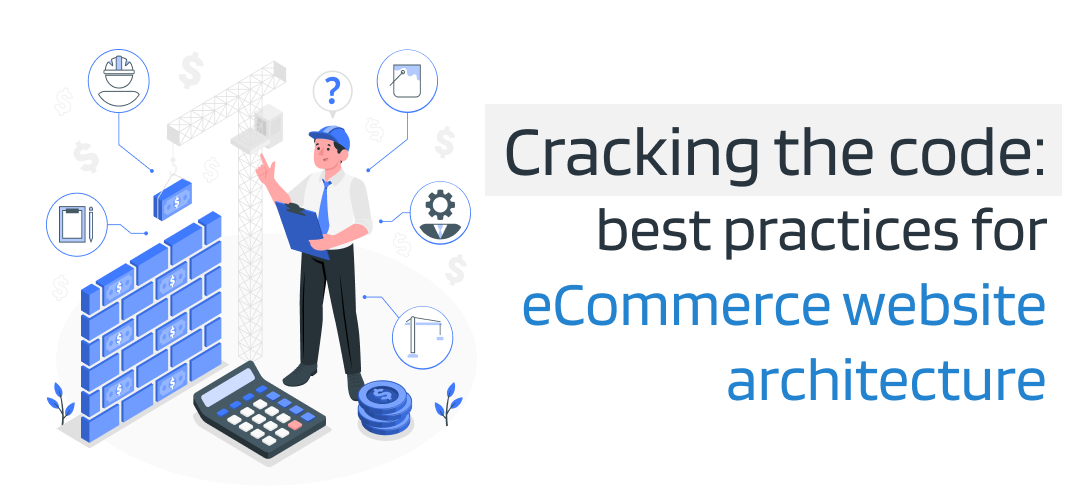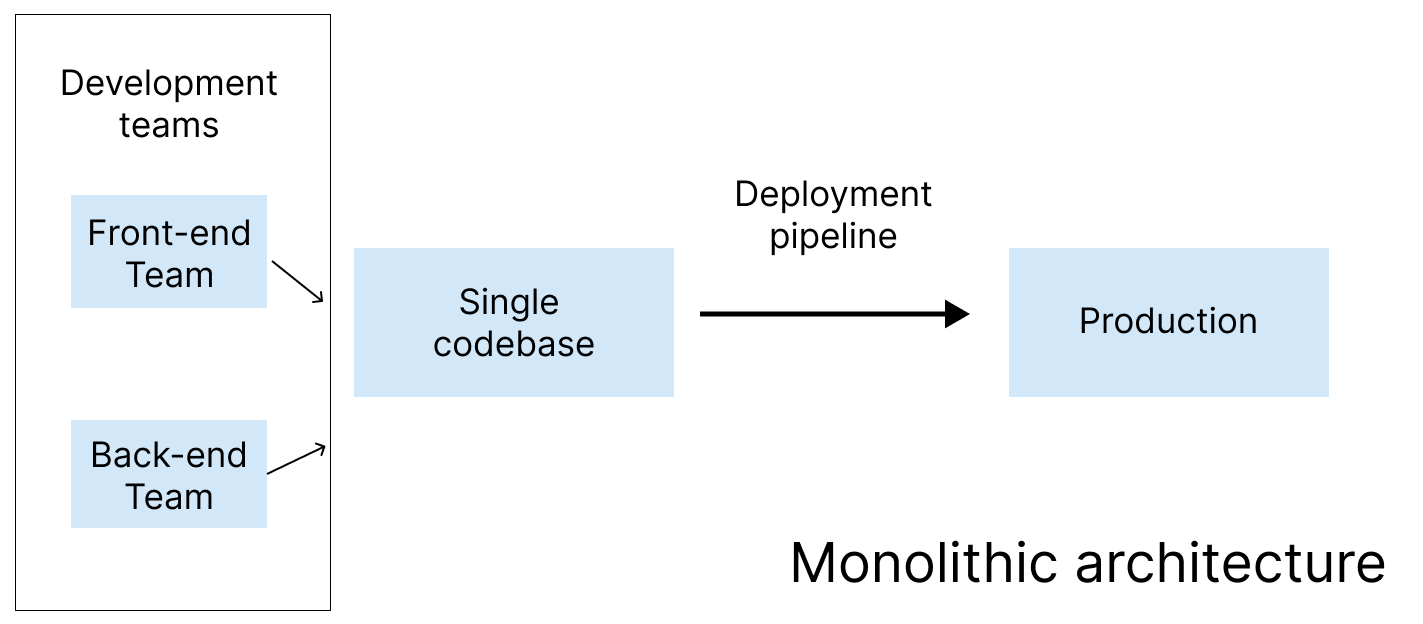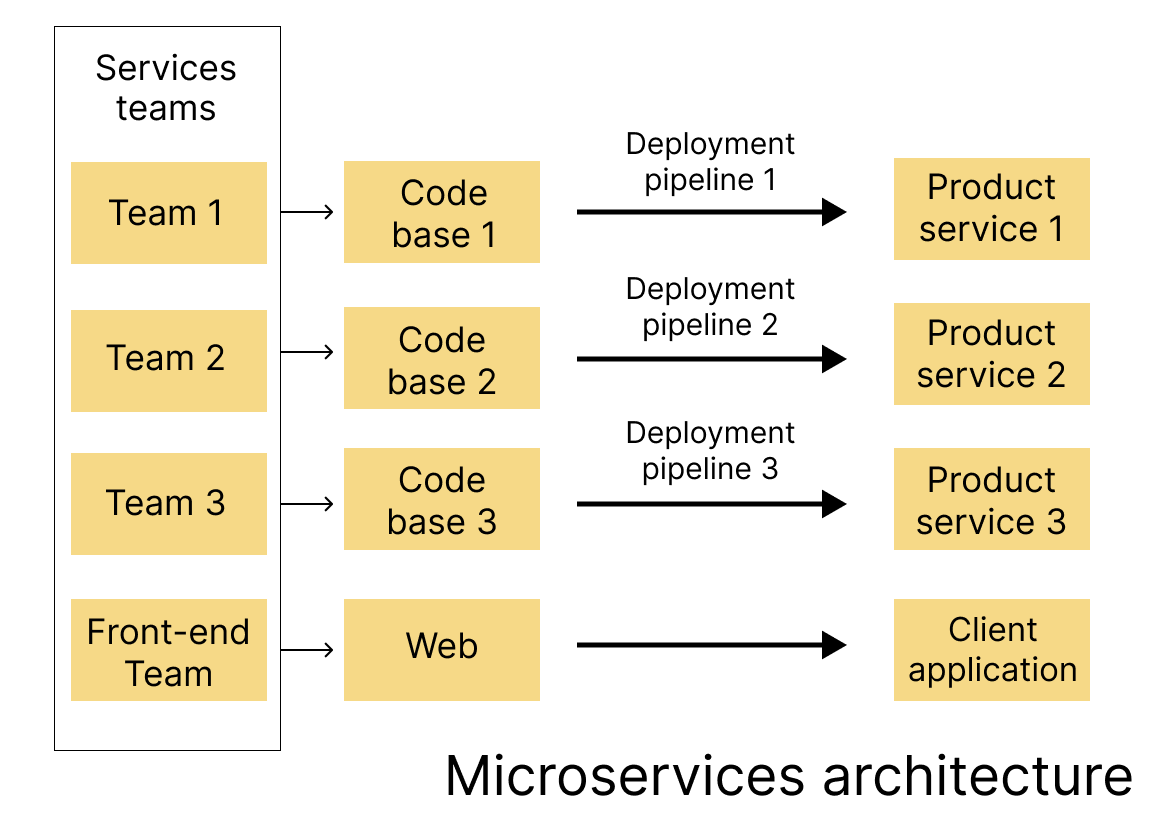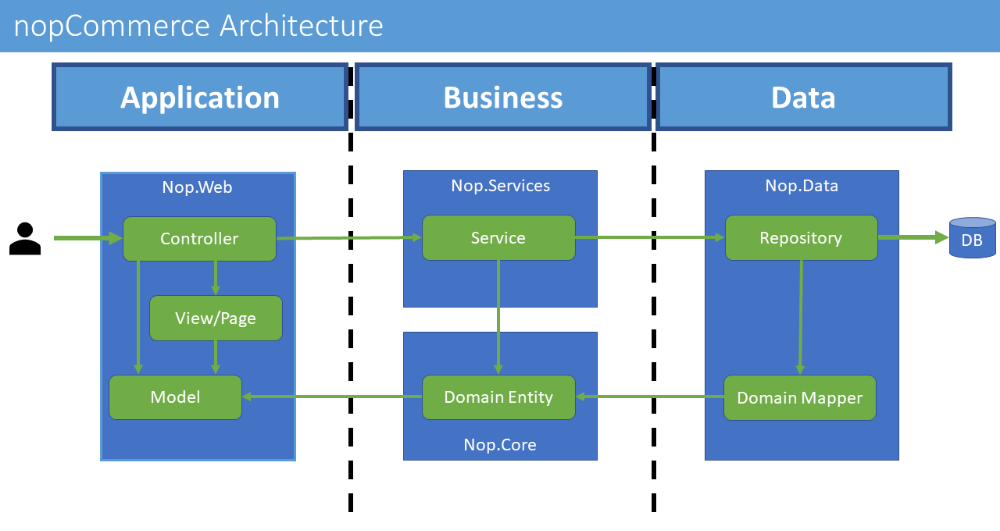
Creating a thriving eCommerce business is akin to construction work. It’s not just about the surface-level aesthetics—the convenient display of products, seamless checkout, or SEO-optimized pages. It is similar to laying the groundwork for a building, which is a robust eCommerce website architecture in the case of an online store.
The parallel holds true as many businesses that seek performance optimization find out that they need a complete overhaul. Legacy architecture is often a silent saboteur, hindering business growth. Thus, an eCommerce architecture should be a dynamic structure, covering both back-end and front-end aspects, that evolves with your business.
In this blog post, you’ll learn more about the inner structure of eCommerce solutions, identify the most common types of eCommerce architectures and get a hand in choosing the right commerce architecture for your business’ scalability and flexibility.
What is eCommerce architecture: its key components and best benefits
Essentially, a good eCommerce architecture encompasses the underlying structure and organization of an online store, governing how information is stored, retrieved, and presented to users.
This intricate system of technologies and frameworks ensures the seamless interaction between databases, servers, and user interfaces. Its key components are as follows:
- eCommerce front-end architecture:
- User Interface (UI): The visual aspect that customers interact with, including design, layout, and navigation.
- User Experience (UX): Enhances customer satisfaction by improving the usability and accessibility of the website.
- eCommerce back-end architecture:
- Server: Manages data storage, processing, and ensures smooth communication between the database and the front-end.
- Database: Where product information, customer data, and transaction details are stored and retrieved from.
- Application logic: Governs the functionality and business rules, ensuring smooth operations and secure transactions.
- Search and information architecture:
- Search functionality: Provides efficient and accurate search results.
- Information organization: Streamlines product categorization, facilitating easy navigation and exploration.
If an eСommerce site structure includes these components, it can grant its owner the following benefits:
- Scalability: A well-designed architecture allows for easy scaling to accommodate a growing product inventory, increased traffic, and expanding business operations.
- Performance optimization: It is increasingly important to ensure swift loading times, reduce bounce rates and enhance the overall user experience.
- Reduced downtime: The lower risk of system failures and downtime contributes to uninterrupted business operations.
- Advanced security: A carefully constructed architecture incorporates robust security measures, protects sensitive customer data and financial transactions.
- Future-proofing: A well-planned eCommerce site architecture can adapt to industry advancements, ensuring its longevity and relevance.
As you can see, implementing a thoughtful eCommerce architecture is not just a technical necessity—it’s a strategic investment. Let’s see how these components are combined in different structures, and which one will work best for your business.
The most popular types of eCommerce project architecture
An eCommerce architecture design comes in different types such as monolithic (two- and three-tier), composable or cloud-based architectures. Each type has its own set of pros and cons, and the ideal choice depends on the unique requirements of the business and the resources available.
It is crucial to weigh the pros and cons of each approach when selecting the best architecture for your eCommerce site, and opt for the one that best aligns with business objectives. For your convenience, we’ve studied the ins and outs, and summarized the results in a digestible format.
Monolithic architecture
The concept of monolithic eCommerce architecture involves constructing a unified and self-contained application based on a single codebase. This approach encompasses the development and deployment of all eCommerce platform components, including the user interface, business logic and database within a single application.
This structure refers to the most common type of monolith, i.e. three-tier architecture. As the name suggests, it embraces three elements: the presentation layer (client), the application layer (business logic), and the data layer (eCommerce database structure).
This layered structure offers a significant benefit since each layer has its own infrastructure, allowing for separate development teams to work on it. This means that each layer can be updated and scaled without any major impact on the other layers. This helps the three-tier eCommerce website architecture handle a lot of processes and provide rich functionality.
Pros:
- Developing, testing and deploying the monolithic architecture is a straightforward process due to its self-contained nature within a single codebase
- Compared to more complex architectures, this one is faster to set up/modify and more affordable to maintain
- Horizontal scaling can be quite challenging, but vertical scaling can be done for the entire application (there can be partial updates not disrupting the overall architecture)
- Easier to manage security and compliance issues with a centralized codebase (i.e. fewer external components and lower dependency on third-party solutions)
- Lower development and operational costs
Cons:
- Parallel development might be challenging due to a single codebase
- Careful coordination and effective communication among teams are essential
- Any change requires deploying the entire application once again, but possible bugs and downtime can be mitigated (for example, by the plugin system in nopCommerce).

Note: The scheme is designed for two teams, but there can be a single development team
Cloud-based architecture
Cloud-based eСommerce portal architecture means that a website is built on a cloud computing platform and the cloud provider manages the server infrastructure.
Alternatively, a serverless architecture can be used, where the website’s code is broken down into smaller functions that run in response to specific events. This approach eliminates the need for constant server management and only uses the necessary computing resources to complete tasks.
While cloud-based solutions may be suitable for smaller businesses with basic feature needs, they are fully controlled by providers and require confirmation for any changes, making them less flexible than other options.
Pros:
- Cloud-based architectures support easy modifications by allowing updates and changes to be implemented without significant downtime
- Cloud services simplify deployment through tools like containerization and automated scaling, allowing for more efficient and flexible deployment strategies
- Cloud platforms provide robust monitoring and debugging tools, making it easier to identify and resolve issues in real-time
- Redundancy and disaster recovery features contribute to risk reduction
- Cloud-based architectures offer shorter time-to-market for eCommerce products
- Infrastructure as Code (IaC) enables automated and consistent infrastructure management
Cons:
- Limited control over the underlying infrastructure and its further customization may pose challenges for certain development requirements
- Reliance on external cloud providers may result in downtime or service disruptions if there are issues with the provider
- Debugging across distributed cloud services may be complex (for example, the most common are compatibility issues)
- Over-dependence on cloud services may lead to vendor lock-in, limiting future scalability options
- Unexpected fees for data transfer, storage, or premium services can contribute to higher-than-anticipated costs
- Data security and compliance depend on the cloud provider’s practices, potentially leading to concerns about data ownership and privacy.
Microservices architecture
Also known as API-first, headless or composable, eCommerce microservices architecture involves building the application using separate, interchangeable components or services. These components are usually offered as APIs, allowing them to be combined and recombined in different configurations. Each service is responsible for a specific function, such as search, inventory management or checkout.
Composable architecture empowers businesses to select the most suitable components for their requirements, effortlessly replace elements, and make more frequent updates. This methodology provides enhanced flexibility, agility, and scalability compared to conventional eCommerce architectures. However, it necessitates a more intricate implementation and management process, demanding substantial investments.
Pros:
- A modular architecture offers businesses the advantage of parallel development, easy customization and seamless integration with other systems and software, making it a highly flexible option (smaller, focused codebases are easier to manage)
- The fault isolation feature ensures that any errors occurring in one module do not impact the entire system
- Horizontal scalability is more granular, allowing specific services to scale independently
- Faster time to market for individual features or services as they can be developed and deployed independently
- Autonomy in development allows teams to choose technologies that align with their expertise
Cons:
- Implementing, managing and debugging this eCommerce architecture is more intricate compared to traditional ones
- It requires a substantial investment in development resources and involves complex server communication
- Additional complexity in managing a distributed system may increase operational costs especially as the application size grows
- More resources are needed for data management (microservices must handle versioning and backward compatibility), and debugging goes through a larger number of logs.

Note: The number of development teams is determined by the number of services
Considering the above, it’s obvious that each eCommerce architecture has areas where it truly shines and aspects where it can face potential performance bottlenecks. To avoid the latter, it’s necessary to carefully analyze your business requirements and current resources.
We’ll recommend answering the following questions:
- Short-term and long-term business goals: do you seek simplicity and faster time-to-market or need to seamlessly integrate additional resources or components as your business grows?
- Development team: do you aim at in-house or outsource? How big is your development team and what is their average level? Who is going to do routine maintenance tasks and updates?
- Launch and operational costs: how much do you plan to invest in your eCommerce solution? What cost-efficiency do you want to achieve? Try calculating the total cost of ownership.
As it often happens, the optimal solution lies somewhere in between. And most eCommerce platforms are striving to combine the best practices and adjust their technology stack to modern changes. Let’s see how nopCommerce deals with such challenges, and what eCommerce website architecture design it offers.
What is nopCommerce’s platform architecture?
nopCommerce is an open-source project built on the latest .NET technologies that follows a clear and comprehensible eCommerce platform architecture. Yep, it adopts a classic monolithic structure, where all elements of the platform, including the admin, front-end, and API services, are integrated into a single application and form a unified environment.
Nevertheless, the nopCommerce source code and architecture are quite easy to understand. The separation of concerns helps keep the growing codebase organized (a common issue for long-living monolithic systems) so that developers can easily find where a particular function is implemented.
According to a three-layer architecture, nopCommerce is also divided into three layers: the Presentation layer, Business layer and Database layer. If the user desires to alter the UI, they only need to modify the Presentation layer, as the other layers remain unaffected by this change. Likewise, if the user wishes to change the database, they only need to make a change in the Database layer, while everything else remains unchanged.
“nopCommerce has an eCommerce enterprise architecture - a very strong example of what a .NET developer should be looking at the front-end, business logic, mid-tier, and database level.”
John Baluka, Software Development Consultant, Microsoft MVP
Presentation layer
This is the topmost level of application related to the user interface, i.e. what the user sees. The primary role of this layer is to convert tasks and results into a format that is comprehensible to the user.
It encompasses pages such as web forms and windows forms, where data is displayed to the user and input is collected from them. The Presentation layer holds utmost significance as it is the visible interface for the user, and a well-designed user interface has the ability to captivate the user’s attention.
Business layer
This is a middleware between the Presentation and Database layers. It serves as the foundation of the application, housing all the data access and business logic. It processes the command, makes logical decisions and performs calculations.
This layer also validates the input conditions before calling a method from the Database layer. This ensures the data input is correct before proceeding, and can ensure that the outputs are correct as well. This validation of input is called business rules.
Database layer
This layer is used to connect the Business layer to the database or data source. It contains methods which are used to perform operations on databases like insert, delete, update, etc. This layer contains stored procedures to query databases. Hence this layer establishes a connection with the database and performs functions on this database.

Flowchart for an eCommerce website powered by nopCommerce
For some, developing an eCommerce application as a monolith architecture might seem like going backward in architectural evolution, but there are certain cases where a monolithic architecture is still the best option, especially when there is strong consistency required.
Pros of nopCommerce:
- Easy to maintain large and complex projects
- Thanks to a logical separation between the Presentation layer, Business layer and Database layers, updation to new graphical environments is easier and faster
- The Business layer provides more security to the Database layer
- Unnecessary methods can be hidden from the Business layer in the Presentation layer
- Data provider queries can be easily updated and OOPs concept can be easily applied to the project
Cons of nopCommerce:
- The structure can be more complex than a simple client-server architecture
- Developers should have good knowledge of object-oriented concepts.
If you want to have a better look at the three-tier eCommerce website system design of nopCommerce, you can check out the official documentation or a valuable extract from the training course.
Looking for more detailed visualization? John Baluka dwelled on nopCommerce’s architecture in an episode of “On .NET” Show. You can watch it below.
How do nopCommerce deal with structural constraints?
Making the most of a monolithic architecture, nopCommerce also offers an ecosystem of plugins that allows to expand the standard functionality at run-time (even the level of business logic and front-end user interface) without the need to recompile the whole project.
nopCommerce uses a plugin system to extend the functionality of the admin panel and uses a widget system to extend the functionality of the website. Plugins and Widgets are a set of independent programs or components that can be added to an existing system to extend some specific functionality and also can be removed from the system without affecting the main system during the process.
So using this pluggable modular/layered architecture, you can add more functionality to the system without altering or editing the source code of the nopCommerce solution. This allows to upgrade or downgrade the nopCommerce solution to the latest version or older version without the need to rewrite plugins and widgets already created.
“The nopCommerce platform has been the foundation for B2C and B2B solutions we’ve developed for our clients over the past 8 years. Their highly extensible plugin architecture has stood the test of time, and continues to evolve on the latest Microsoft tech stack.”
Richard Reed, Director of Platform Development at Spinutech
Within this eCommerce schema design, nopCommerce supports the following types of plugins:
- Discount Rules (IDiscountRequirementRule) for defining requirements that must be met for a discount to be applied
- Exchange Rate Provider (IExchangeRateProvider) for getting the exchange rates for currencies
- External Authentication Method (IExternalAuthenticationMethod) for adding new external authentication methods (e.g. “Log in with Facebook”)
- Payment Method (IPaymentMethod), for example, Paypal
- Shipping Rate Computation Method (IShippingRateComputationMethod) for calculating shipping rates
- Tax Provider (ITaxProvider) for calculating tax rates
- Widgets (IWidgetsPlugin) for all the cases when a plugin doesn’t fit any other type.
Is it possible to go headless with nopCommerce?
Although nopCommerce was not built on the API-first principle, it still supports a headless framework through a Web API plugin. It provides access to all platform functions as well as full control over database entities. It is a RESTful API built according to the OpenAPI 3.0 specification (OAS).
Headless commerce architecture separates the front-end and back-end of the website, which provides more flexibility and customization options. The official nopCommerce Web API plugin covers all methods of nopCommerce.
This kind of ecommerce system is the best one for building strong and future-proof eСommerce businesses with fast time-to-value. Such a modular eCommerce architecture and open-source technology offer enough flexibility to build websites according to individual specifications without disrupting existing storefront features.
Does nopCommerce give a good run for your money?
While many companies are switching to microservices, nopCommerce shows that a well-structured and mature monolithic architecture can still be used for modern large eCommerce projects.
This cross-platform and headless eCommerce solution is becoming an enterprise application and gaining popularity within many online businesses.
Final thoughts
All architectures for your eCommerce website have their strengths and weaknesses. But regardless of the camp you’re in, architectural success lies not in blind allegiance but in a thoughtful and strategic approach as each architecture is suitable for different scenarios, and the choice ultimately depends on unique requirements and business goals.
In the end, there is no one-size-fits-all solution. To avoid over-engineering and over-spending, it is necessary to choose the architecture that satisfies such non-functional requirements as scalability, availability, etc. at solving a particular task.
While some cons exist in every architecture, many of them can be mitigated with proper planning, training and a strategic approach.
In this context, the architecture of nopCommerce should be given more credit. Its greatness lies in its flexibility, scalability, modularity and modern technology stack, supporting cross-platform capabilities. Whether you’re a mid-sized business owner or an enterprise-level eCommerce operation, nopCommerce provides a solid foundation for building and expanding your online store.